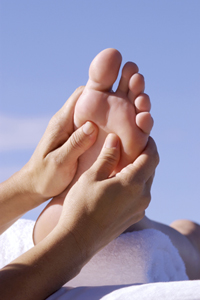Self-administered Acupressure Shows Benefit by Reducing Persistent Cancer-related Fatigue

A small pilot study assessed the potential effects of self-administered acupressure for the reduction of persistent cancer-related fatigue (PCRF) symptoms. Acupressure is a technique derived from acupuncture, which is a component of Traditional Chinese Medicine. It involves using physical force applied to acupuncture points by the hand, elbow, or with various devices, with the intent of treating a disease or reducing symptoms.
Suzanna Zick, N.D., M.P.H., of the University of Michigan Medical Center, and colleagues, enrolled 43 participants in a self-administered acupressure pilot study with a primary objective of testing the effect of two intensities of self-administered acupressure on the severity of fatigue over 12 weeks. The study compared stimulating acupressure [high (HIS) or low (LIS) doses] with relaxation acupressure (RA). The Brief Fatigue Survey (BFI) was used to assess participant fatigue levels. The BFI is a 10-question assessment with a score of “0” considered no fatigue or impact on functioning, and “10” being the “worst imaginable fatigue” or fatigue that “completely interferes” with normal daily functioning.
Zick and colleagues hypothesized that the stimulating acupressure treatments would potentially have opposing actions on fatigue when compared to RA. Treatment effects were assessed by changes in fatigue on the BFI.
Participants were given hands-on instructions from one of three acupressure practitioners teaching them the correct pressure and placement of acupressure points. Participants in the HIS and RA groups self-administered acupressure for 30 or 27 minutes, respectively, twice per day. The LIS group administered three times per week for 30 minutes a day. Participants were also given a diagram with written instructions of the proper acupressure points and a timer to ensure they were doing the treatment for the correct amount of time. Participants in all groups were “instructed to make small clockwise circles with their index finger, thumb, or pencil eraser to stimulate the points for three minutes per point with sufficient pressure to evoke a “de qi” sensation (i.e., dull ache, tingling and soreness).” The participants were instructed to use the same intensity of pressure at acupressure points for all three groups. HIS and LIS points were identical; RA involved different points, although some overlapped with the HIS and LIS groups.
Participants were randomized to each treatment group and blinded to the type of treatment they were receiving. Results showed that changes in the severity of fatigue, as measured by the BFI, were significantly different across treatment groups with the greatest reductions in the relaxation acupressure group. BFI reduced by 4.0 (70.5%) points (from the 10-point BFI scale) in the RA group and 2.2 (44.8%) and 2.7 (49.5%) in the HIS and LIS group, respectively. It was found that the majority of change in BFI was observed in the first four weeks of treatment regardless of group, and that at seven weeks treatment effects reached their peak.
Results of participant compliance showed that it did not appear feasible to ask participants to perform acupressure more than once daily, as adherence was lower in the HIS and RA groups where participants were asked to perform acupressure twice daily. The LIS group, who performed acupressure only 3 times a week, had greater compliance. As the results showed the BFI reduction in the HIS and LIS groups to be similar, study authors suggested that the duration of time acupressure is performed in weeks, versus how often daily may have a greater importance in decreasing fatigue. This assumption was compared to other trials that showed greater reductions during trials with longer duration in weeks of acupuncture sessions. While the authors did not examine mechanisms of action as to how acupressure decreased fatigue, they did hypothesize that their choice of acupressure points specifically in the RA group could have been reasons for the decrease, and may have improved quality of participants’ sleep.
Limitations of this study are important to take into consideration, such as the small study size of only 43 participants, with no control group arm. Patients were largely homogenous (white women diagnosed with breast, endometrial, or ovarian cancer), limiting the generalizability of the results. However, despite these limitations, this study provides promising results for this low cost, self-administered therapy that has virtually no side effects. More information about this study is available by reviewing the article: http://www.ncbi.nlm.nih.gov/pubmed/20924499
Zick and colleagues have recently started another clinical trial for acupressure for PCRF, supported by NCI grant (R01CA151445), which is based on the pilot study outlined above. More information about this trial is available online from a study protocol article, http://www.ncbi.nlm.nih.gov/pubmed/22909076, and through the Clinicaltrials.Gov website, http://clinicaltrials.gov/show/NCT01281904. This study is currently recruiting patients.





